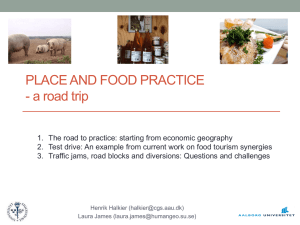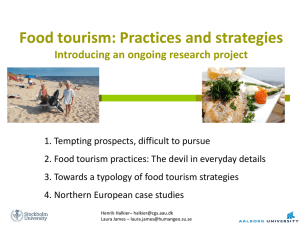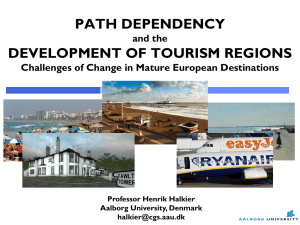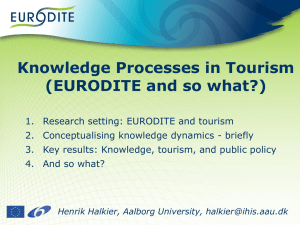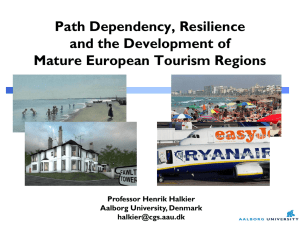Halkier Soenderborg Nov 2014
advertisement
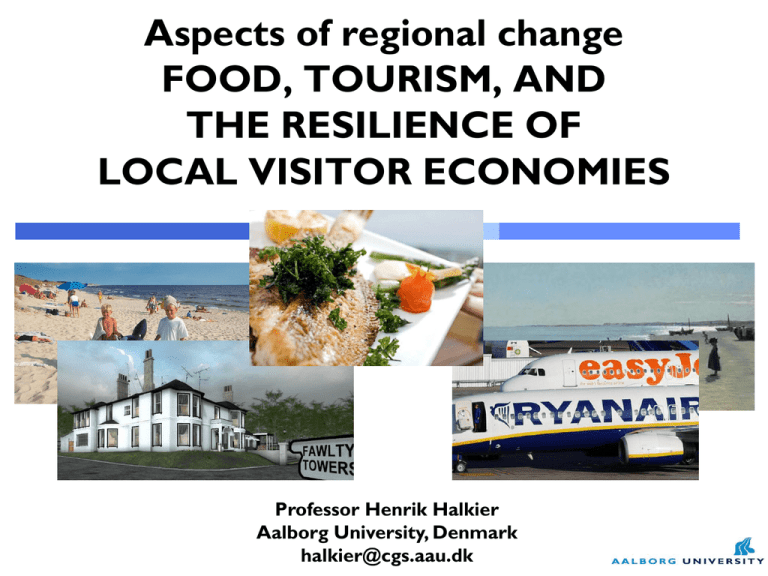
Aspects of regional change FOOD, TOURISM, AND THE RESILIENCE OF LOCAL VISITOR ECONOMIES Professor Henrik Halkier Aalborg University, Denmark halkier@cgs.aau.dk Aspects of regional change FOOD, TOURISM, AND THE RESILIENCE OF LOCAL VISITOR ECONOMIES 1. Path dependency and development of regions and tourist destinations 2. Cross-sectoral synergies: Food and tourism in North Jutland and Suffolk 3. 4. Resilient local visitor economies: North Jutland recovering from the crisis? Concluding remarks Professor Henrik Halkier Aalborg University, Denmark halkier@cgs.aau.dk 1 PATH DEPENDENCY AND CHANGE Regions and destinations From path dependency as (negative) lock-in… System of institutions maintaining direction Firms, regulation, actor behaviour, discourse Sudden change, from outside system (Martin/Sunley 2006, Howlett/Rayner 2006) (Martin/Sunley 2014, Martin 2010, Mahoney 2000) Changes in demand and competition … towards less rigid paths Co-existence of institutions in regions Plasticity of institutions (Martin/Sunley 2014, Hassink 2010) (Strambach 2010, Strambach/Halkier 2013) Path creation as contextualised strategic action Henrik Halkier – halkier@cgs.aau.dk (Karnøe/Garud 2012) 1 PATH DEPENDENCY AND CHANGE Regions and destinations Importance of accounting for: Development of individual institutions (drift/conversion) Complex interaction of institutions (Butler 1980) (layering/displacement) Role of agency/actors in continuity and change (Mahoney/Thelen 2010, Martin 2010, Hassink 2010) (Schneiberg 2007, Karnøe/Garud 2012) (Ma/Hassink 2013, based on Martin 2010) Henrik Halkier – halkier@cgs.aau.dk 1 RECONCEPTUALISING TOURIST DESTINATIONS Actor groups and institutions in destination development. Source: Henrik Halkier & Anette Therkelsen: Breaking out of Tourism Destination Path Dependency? Exploring the Case of Coastal Tourism in North Jutland, Denmark, German Journal of Economic Geography, 57, 1-2 Henrik Halkier – halkier@cgs.aau.dk 1 Seaside maturity in North Jutland, Denmark TIES THAT BIND Families with kids, nature-based, seasonal, neighbouring markets 3000000 2500000 Automobile, self-catering, week-based 2000000 Marketing 1500000 Domestic International 1000000 Civil ownership/co-use, life-style entrepreneurs, 500000 monopolitistic rental bureaus National ownership, planning restrictions 1992 1993 1994 1995 1996 1997 1998 1999 2000 2001 2002 2003 2004 2005 2006 2007 2008 2009 2010 2011 2012 2013 0 Multi-level sectoral policy network, uneven local priority Henrik Halkier – halkier@cgs.aau.dk 1 Seaside maturity in North Jutland, Denmark TOWARDS A NEW PATH? No-kid high-spenders, +culture, short breaks LAYERING: Flying in? LAYERING: Re-branding Cross-sectoral networks, new transport links? Henrik Halkier – halkier@cgs.aau.dk 1: More dull, reinforcing 1. CONVERSION: Flexible planning 2. DRIFT: Innovation and coordination 2: Uneven local change 1 SUMMING UP Maturity, thinness and economic change Case study conclusions Continued dominance of existing institutions Civil ownership of accommodation Visitor perceptions of ‘a summer place’ ‘Thinness’ of innovative initiatives Wider perspectives Usefulness of evolutionary perspective for study of tourism destinations Underlines role of cultural values/institutions in regional development Need for continued conceptual debate about less rigid paths Henrik Halkier – halkier@cgs.aau.dk 2 CROSS-SECTORAL SYNERGIES Food and tourism in North Jutland and Suffolk From tempting prospects of synergy … tourists will eat anyway food experience add to attraction of destination local food an exotic quality boost local food production directly/indirectly … to international destination food brand attractions of regional food communicated to visitors regional food experiences demanded by visitors regional food experiences must be produced regional food made accessible to visitors Henrik Halkier – halkier@cgs.aau.dk 2 CROSS-SECTORAL SYNERGIES Food and tourism in North Jutland and Suffolk Food practices FEEDING TOURISTS FOOD TOURISM Eating Sustenance Experience Cooking Generic Place specific Retailing National Localized Producing Standardized Specialized Henrik Halkier – halkier@cgs.aau.dk 2 CROSS-SECTORAL SYNERGIES Food and tourism in North Jutland and Suffolk Conceptualising economic development strategies Contextual drivers (destination branding, boost local food production, food scares) Available resources (tourism/food, public/private) Change strategies (aims, targets) (Halkier 2006, Dredge & Jenkins 2007) Food tourism change strategies Main level of intervention Firm-level Primary policy target Food Tourism Innovating Developing experience Destination Localising consumption Henrik Halkier – halkier@cgs.aau.dk Promoting image 2 CROSS-SECTORAL SYNERGIES Food and tourism in North Jutland and Suffolk Two case studies: North Jutland (DK), Suffolk (UK) Coastal destinations with rural hinterlands Food tourism ambitions, no ‘magnificent culinary heritage’ Suffolk – wheat/barley, poultry, pork, vegetables North Jutland – grain, milk, pork, seafood Interviews with producers, retailers, restaurants, policymakers Henrik Halkier – halkier@cgs.aau.dk 2 Food tourism in North Jutland and Suffolk FINDINGS: RESOURCES North Jutland (DK) Suffolk (UK) • Seasonal coastal destination Tourism • Mainly self-catering families resources • Many ‘grill bars’, few high-end restaurants • Seasonal coastal destination • Mainly self-catering couples • Many gastro-pubs, few high-end restaurants Culinary • No signature dishes resources • Emerging local quality produce • No signature dishes • Expanding local quality produce Private sector resources • Some small-scale producers • Some small-scale fishing • Fragmented tourism sector • EU LEADER rural programme Public • Established, well-resourced sector DMOs resources • • • • • Many small-scale producers Some small-scale fishing Some larger ‘quality’ producers Fragmented tourism sector Commercial distribution to/via supermarkets etc. • EU LEADER rural programme • Limited support for private-sector led DMOs 2 Food tourism in North Jutland and Suffolk FINDINGS: DRIVERS AND STRATEGIES North Jutland (DK) Policy drivers Initiatives • Extension of tourism season • Rural development • ‘New Nordic’ cuisine Suffolk (UK) • Extension of tourism season • Rural development • Food scares - provenance • Destination branding with food • Destination branding with food • Support for food events • Support for food events • (LEADER) food network to • LEADER diversification projects link/profile small producers (and restaurants) • Signature dishes with local ingredients/story-telling • ‘New Nordic’ is urban • No joint distribution Challenges • Limited growth of small-scale quality production Henrik Halkier – halkier@cgs.aau.dk • Fragmented tourism policy landscape • Limited financial resources for promotion 2 Food tourism in North Jutland and Suffolk SUMMING UP Strategies focus on Changes visible to visitors: branding, events, menus, (diversification) New temporality (outside main season) NOT localising food chain Strategic differences reflect Perceived/experienced intensity of demand Degree of availability of local food (producers, retailers) Alternatives to diversification for small farmers (wage labour) Dominant political agendas: Tourism (DK) versus foo (UK) (National) preferences for particular policy instruments (networks vs grants) Long-term strategic weaknesses Limited funding for promotion/DMOs (UK) Limited addressing of production/distribution density (DK) Weak combination of branding AND development in sector-based governance (DK/UK) Henrik Halkier – halkier@cgs.aau.dk 3 Resilient local visitor economies in North Jutland RECOVERING FROM THE CRISIS? 3000000 2500000 2000000 1500000 1000000 Domestic International 500000 0 Regional and local strategies focusing on Increase visitor spending Extend season season Innovation rather than marketing Henrik Halkier – halkier@cgs.aau.dk 3 Resilient local visitor economies in North Jutland RECOVERING FROM THE CRISIS? Skagen Traditional upmarket destination/day visitors Passive gazing on nature and culture Well-functioning and innovative DMO Klitmøller Recently emerging destination Active engagement with nature Ongoing skirmishes between local stakeholders Henrik Halkier – halkier@cgs.aau.dk 3 Resilient local visitor economies in North Jutland RECOVERING FROM THE CRISIS? Skagen (Frederikshavn overnights) International recovery (esp. non-German) Limited extension of season Klitmøller (Thisted overnights) Initial German resilience, then slump Very limited Danish recovery Growing local surfing community Commercial overnight stays. Overnight stays per year. Source: Statistics Denmark StatBank. Henrik Halkier – halkier@cgs.aau.dk 3 Resilient local visitor economies in North Jutland RECOVERING FROM THE CRISIS? Economic activity associated with tourists staying in commercial accommodation by locality. Million DKK, current prices. Source: VisitDenmark’s tourist satellite accounts 2008ff . A different kind of recovery? Uneven recovery in overnights Clear recovery in economic activity Moving towards better-off visitors Local resilience through growth of domestic tourism? Henrik Halkier – halkier@cgs.aau.dk 4 CONCLUDING REMARKS Key aspects of regional change Development of individual institutions Complex interactions of institutions Role of agency/actors in continuity and change Wider spatial/international context Policy implications Importance of re-thinking the ‘taken for granted’ Transition from ‘paper synergies’ to ‘real-world change’ uneven Policies can be path dependent Producer-driving policies may ignore markets/competitors Henrik Halkier – halkier@cgs.aau.dk 4 FURTHER READINGS Henrik Halkier and Anette Therkelsen (2013) Breaking out of Tourism Destination Path Dependency? Exploring the Case of Coastal Tourism in North Jutland, Denmark. German Journal of Economic Geography 57: 39-51. Laura James and Henrik Halkier (2015) Regional development platforms and related variety: exploring the changing practices of food tourism in North Jutland, Denmark. European Urban and Regional Studies. Henrik Halkier and Laura James (2015) Destination Dynamics, Path Dependency and Resilience: Regaining Momentum in Danish Coastal Tourism Destinations, in Patrick Brouder et al. (eds.) Tourism Evolutionary Geography, Routledge. Henrik Halkier – halkier@cgs.aau.dk
